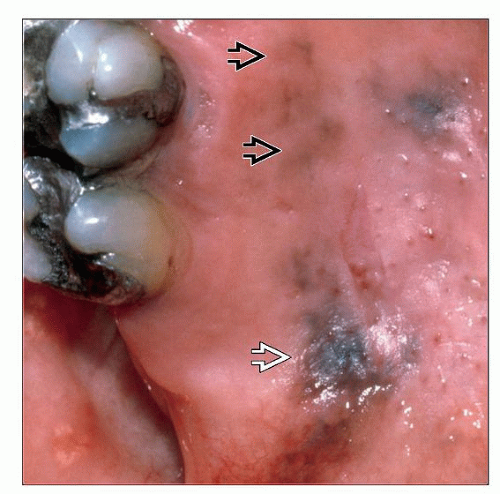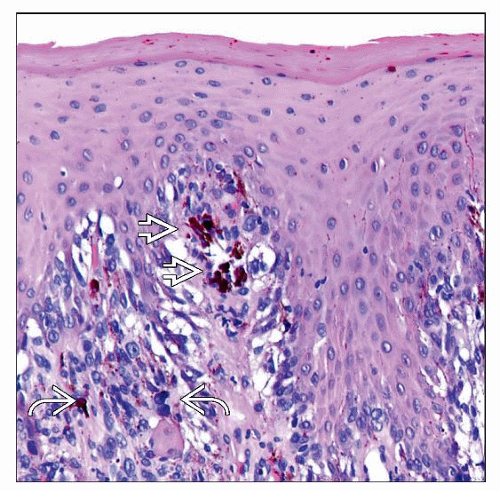Oral Melanoma
Lester D. R. Thompson, MD
Key Facts
Terminology
Malignant neural crest-derived neoplasm with melanocytic differentiation
Clinical Issues
Extremely rare, accounting for < 1% of all melanomas
Represent < 0.5% of all oral malignancies
Mean in 6th-7th decades
Male > female (2.5-3:1)
Hard palate and maxillary alveolus are most common sites of involvement (~ 80%)
Cervical lymph nodes mets reported in > 50% of cases at presentation
Asymmetric, painless, pigmented lesion with irregular borders
Radical surgical excision
Overall, poor prognosis (median: 2 years)
Image Findings
Oral cavity mass with high T1WI on MR
Microscopic Pathology
Pagetoid spread or in situ component with single or multiple melanoma cells in superficial epithelium
Epithelioid or spindle-shaped morphology to melanocytes containing fine melanin granules
1/3 of cases have bone/cartilage invasion
Ancillary Tests
Generally diffuse and strong staining for S100 protein, HMB-45, and vimentin
Top Differential Diagnoses
Metastatic melanoma, spindle cell squamous cell carcinoma, pleomorphic sarcoma
TERMINOLOGY
Definitions
Malignant neural crest-derived neoplasm with melanocytic differentiation
Atypical melanocytes at epithelial-connective tissue interface with upward migration or connective tissue invasion
ETIOLOGY/PATHOGENESIS
Etiology
Unknown (no ultraviolet exposure)
CLINICAL ISSUES
Epidemiology
Incidence
Extremely rare, accounting for < 1% of all melanomas
0.02/100,000 population/year in USA
Represent about 50% of all head and neck mucosal melanomas
Represent < 0.5% of all oral malignancies
Unlike cutaneous melanoma, oral melanoma incidence has been stable
Age
Mean in 6th-7th decades
Rare in pediatric age group
Gender
Male > female (2.5-3:1)
Ethnicity
More common in Japan and western Africa
Site
Hard palate and maxillary alveolus are most common sites of involvement (˜ 80%)
Remaining 20% include
Mandibular gingivae
Buccal mucosa
Floor of mouth and tongue
Presentation
Most arise de novo although 1/3 are preceded by pigmented lesion for a few months or years
“Melanosis” reported before development of melanoma
Asymmetric, painless, pigmented lesion
Irregular borders or outlines
Black, purple, red, gray
15% of oral melanomas are amelanotic
Macular, with nodular areas
Many patients present at advanced stage with pain, ulceration, loose teeth
Cervical lymph nodes mets reported in up to 75% of cases at presentation
Distant metastases present in about 50% at presentation
Treatment
Surgical approaches
Radical surgical excision
Clear margins not always possible due to vital structures
Recommendation for regional lymph node dissection, even in clinically negative neck
Adjuvant therapy
No clear cut evidence that chemotherapy or immunotherapy for oral melanoma provides any survival benefits
Generally used for palliative purposes
Not recommended as a single modality treatment
Stay updated, free articles. Join our Telegram channel

Full access? Get Clinical Tree








